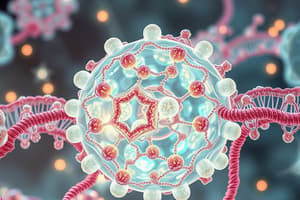Podcast
Questions and Answers
What is the typical range of the resting membrane potential in neurons?
What is the typical range of the resting membrane potential in neurons?
- -90 to -100 millivolts
- -70 to -90 millivolts (correct)
- 0 to -30 millivolts
- -40 to -60 millivolts
The leaky sodium channels have a higher permeability compared to leaky potassium channels in resting neurons.
The leaky sodium channels have a higher permeability compared to leaky potassium channels in resting neurons.
False (B)
What is the main function of the sodium-potassium ATPase pump?
What is the main function of the sodium-potassium ATPase pump?
To pump three sodium ions out of the cell and two potassium ions into the cell.
The equilibrium potential for potassium, calculated using the Nernst equation, typically yields around ______ mV.
The equilibrium potential for potassium, calculated using the Nernst equation, typically yields around ______ mV.
Match the following ion channels with their functions:
Match the following ion channels with their functions:
What is the resting membrane potential of a neuron at rest?
What is the resting membrane potential of a neuron at rest?
Graded potentials can only lead to depolarization of the neuron.
Graded potentials can only lead to depolarization of the neuron.
What ions are primarily involved in generating action potentials?
What ions are primarily involved in generating action potentials?
The threshold voltage for initiating an action potential is approximately ______ mV.
The threshold voltage for initiating an action potential is approximately ______ mV.
Match the following terms with their definitions:
Match the following terms with their definitions:
Study Notes
Resting Membrane Potential
- Defined as the voltage difference across a cell membrane when the cell is at rest, typically between -70 to -90 millivolts in neurons.
- Exists in all cell types, not just neurons.
Key Mechanisms Establishing Resting Membrane Potential
-
Sodium-Potassium ATPases (Na+/K+ Pump)
- Pumps three sodium ions out of the cell and two potassium ions into the cell.
- Creates a slight negative charge inside the cell by excluding more positive ions than it brings in.
- Establishes concentration gradients: higher sodium outside and higher potassium inside the cell.
-
Leaky Potassium Channels
- These channels allow potassium ions to move freely across the membrane.
- Potassium moves out of the cell down its concentration gradient, leading to a more negative interior.
- Unoccupied anions inside the cell (negatively charged ions or large proteins) contribute to increased negativity.
-
Leaky Sodium Channels
- Allow some sodium ions to enter the cell, though the permeability to potassium is significantly greater.
- Sodium moves into the cell down its concentration gradient, making the inside slightly less negative but not enough to counteract the outflow of potassium.
Concentration Gradients
- The Na+/K+ pump and leak channels work together to maintain relative ion concentrations, crucial for cell function.
- Potassium is much more permeable than sodium in resting neurons, which is why the resting membrane potential is closer to the equilibrium potential of potassium (-90 mV).
Nernst Potential
-
Used to calculate the equilibrium potential for ions, reflecting the balance between concentration gradient and electrostatic forces.
-
For potassium:
- Equation: E(K) = 61.5 / z * log([K+]outside/[K+]inside)
- Typical values yield around -90 mV.
-
For sodium:
- Equation: E(Na) = 61.5 / z * log([Na+]outside/[Na+]inside)
- Typical values yield around +70 mV.
Summarizing Resting Membrane Potential
- Resting membrane potential results from combined influences of the sodium-potassium pump, leaky potassium channels, and leaky sodium channels.
- Calculating resting membrane potential involves understanding the balance of these ion distributions and their respective equilibrium potentials, with the final resting membrane potential being a weighted average of the potentials of sodium and potassium ions.### Resting Membrane Potential
- Membrane potential of a neuron at rest is approximately negative 70 millivolts (mV).
- This is influenced by ion permeability, particularly potassium (K+) which moves out of the cell more readily than sodium (Na+).
Graded Potentials
- Graded potentials can depolarize (make less negative) or hyperpolarize (make more negative) the neuron.
- To depolarize towards threshold voltage for action potential, which is around negative 55 mV, slight depolarization is needed.
- Hyperpolarization can occur, reducing the membrane potential, for example, to negative 90 mV, thus inhibiting the neuron.
EPSPs and IPSPs
- Excitatory postsynaptic potential (EPSP) refers to the depolarization caused by the influx of positive ions (like Na+ or Ca2+) when a neurotransmitter (e.g., glutamate) binds to ligand-gated ion channels.
- Inhibitory postsynaptic potential (IPSP) occurs when negative ions (like Cl-) flow in or positive ions (like K+) flow out, leading to hyperpolarization.
Neuronal Communication
- Neurons are classified as presynaptic (sending signals) and postsynaptic (receiving signals) based on their position relative to the synapse.
- The interaction between presynaptic and postsynaptic neurons occurs at synapses, where neurotransmitters are released and interact with receptors.
Types of Summation
- Temporal Summation: Multiple signals from a single presynaptic neuron occur in rapid succession, increasing the likelihood of reaching threshold.
- Spatial Summation: Multiple presynaptic neurons fire simultaneously at the postsynaptic neuron, cumulatively raising the membrane potential towards threshold.
Action Potential Initiation
- Upon reaching the threshold voltage (negative 55 mV) at the axon hillock, voltage-gated sodium channels open, allowing Na+ to rush into the cell.
- This influx transforms the membrane potential from negative 55 mV to positive 30 mV, leading to the action potential.
Axon Hillock and Trigger Zones
- The axon hillock is known as the trigger zone where action potentials are initiated.
- It is densely populated with voltage-gated sodium channels that are crucial for action potential generation.
Voltage Changes During Action Potential
- The rapid influx of sodium ions during an action potential shifts the cell's membrane potential dramatically, causing depolarization that swiftly transitions to a positive intracellular environment.### Action Potential Generation
- Resting membrane potential is around negative 70 millivolts.
- Threshold potential is approximately negative 55 millivolts, triggering action potentials.
- At positive 30 millivolts, the inactivation gate of voltage-gated sodium channels closes, halting sodium entry.
Mechanism of Depolarization
- Depolarization occurs when sodium ions rush into the cell after activation of voltage-gated sodium channels.
- The influx of sodium raises the internal voltage from negative 70 to positive 30 millivolts.
- The sequence begins at the axon hillock, propagating a depolarizing wave down the axon.
Role of Calcium in Neurotransmitter Release
- At positive 30 millivolts, voltage-gated calcium channels activate, allowing calcium ions to enter the axon terminal.
- Calcium facilitates the fusion of synaptic vesicles with the cell membrane, releasing neurotransmitters into the synaptic cleft.
Key Definitions
- Depolarization: The process of making the inside of the cell more positive relative to the outside.
- Repolarization: The return of the cell’s interior voltage back to resting potential after depolarization.
- Hyperpolarization: The condition where the inside of the cell becomes more negative than the resting potential.
Repolarization Process
- Voltage-gated potassium channels open following the peak voltage of positive 30 millivolts.
- As potassium exits the cell, it brings the voltage down to negative 90 millivolts, causing hyperpolarization.
- The sodium-potassium pumps and leaky channels eventually restore resting membrane potential to negative 70 millivolts.
Action Potential Trajectory
- Action potentials follow the sequence of depolarization followed by repolarization, with channels activating and inactivating in response to voltage changes.
- The absolute refractory period occurs between the peak of the action potential and return to resting potential, during which the neuron cannot be re-stimulated.
Configuration of Voltage-Gated Sodium Channels
- At resting state, the activation gate is closed and the inactivation gate is open.
- During depolarization, the activation gate opens while the inactivation gate starts to close.
- At the peak (positive 30 millivolts), the activation gate is open and the inactivation gate is shut, preventing further sodium influx.
Refractory Periods
- Absolute Refractory Period: Period during which no stimulus can trigger another action potential, corresponding to when inactivation gates are closed.
- Relative Refractory Period: Follows the absolute refractory period; the neuron can potentially be re-stimulated with a stronger than usual stimulus.
Summary of Resting and Action Potentials
- Transition from resting potential (-70mV) to threshold potential (-55mV) is influenced by excitatory postsynaptic potentials (EPSPs).
- Returning to a stable resting potential involves the inactivation of channels and the action of pumps and channels to balance ion concentrations.
Resting Membrane Potential
- Resting membrane potential is the voltage difference across a cell membrane when at rest, typically between -70 to -90 mV in neurons, and is present in all cell types.
Key Mechanisms Establishing Resting Membrane Potential
-
Sodium-Potassium ATPases (Na+/K+ Pump):
- Transports three sodium ions out and two potassium ions into the cell, establishing a net negative charge inside.
- Creates concentration gradients with higher sodium outside and higher potassium inside the cell.
-
Leaky Potassium Channels:
- Allow potassium ions to flow out of the cell, making the interior more negative.
- Unoccupied negatively charged ions inside the cell enhance the membrane's negativity.
-
Leaky Sodium Channels:
- Permit a small influx of sodium ions, contributing to less negativity inside the cell but less than the outflow of potassium.
Concentration Gradients
- The Na+/K+ pump and leak channels maintain vital ion concentrations, essential for cell functionality.
- The resting membrane potential aligns closer to potassium's equilibrium potential around -90 mV due to higher potassium permeability.
Nernst Potential
-
Formula used to calculate equilibrium potentials for ions, balancing concentration gradients and electrostatic forces.
-
Potassium Equilibrium Potential:
- Calculated as E(K) = 61.5 / z * log([K+]outside/[K+]inside) yielding approximately -90 mV.
-
Sodium Equilibrium Potential:
- Calculated as E(Na) = 61.5 / z * log([Na+]outside/[Na+]inside) yielding approximately +70 mV.
Summarizing Resting Membrane Potential
- Resultant from the sodium-potassium pump, leaky potassium, and leaky sodium channels.
- Final resting membrane potential is a weighted average of sodium and potassium ion potentials.
Graded Potentials
- Graded potentials can either depolarize (make less negative) or hyperpolarize (make more negative) the neuron.
- Depolarization is needed to reach the action potential threshold of approximately -55 mV.
- Hyperpolarization can push the membrane potential to around -90 mV, inhibiting neuron activity.
EPSPs and IPSPs
-
Excitatory Postsynaptic Potential (EPSP):
- Results from positive ion influx (e.g., Na+ or Ca2+) when a neurotransmitter binds to receptors.
-
Inhibitory Postsynaptic Potential (IPSP):
- Occurs due to the flow of negative ions (like Cl-) or the outflow of positive ions (like K+), resulting in hyperpolarization.
Neuronal Communication
- Neurons are categorized as presynaptic (sending signals) and postsynaptic (receiving signals) regarding their synaptic position.
- Communication happens at synapses where neurotransmitters are released and interact with receptors.
Types of Summation
-
Temporal Summation:
- Involves multiple signals from one presynaptic neuron in quick succession, raising the likelihood of reaching the threshold.
-
Spatial Summation:
- Multiple presynaptic neurons fire simultaneously at the postsynaptic neuron, cumulatively elevating the membrane potential towards the threshold.
Action Potential Initiation
- When threshold voltage (approximately -55 mV) is met at the axon hillock, voltage-gated sodium channels open, leading sodium ions to flood into the cell.
- This influx shifts the membrane potential sharply from -55 mV to approximately +30 mV, resulting in an action potential.
Axon Hillock and Trigger Zones
- The axon hillock acts as the trigger zone for action potentials, containing a high density of voltage-gated sodium channels critical for their generation.
Voltage Changes During Action Potential
- Rapid sodium influx during an action potential dramatically depolarizes the cell, rapidly transitioning towards a positive intracellular environment.
Studying That Suits You
Use AI to generate personalized quizzes and flashcards to suit your learning preferences.
Description
Explore the resting membrane potential essential for cellular function. This quiz covers the key mechanisms like the Sodium-Potassium ATPase and leaky channels that help establish and maintain this electrical state across cell membranes. Ideal for students learning about cellular physiology.




